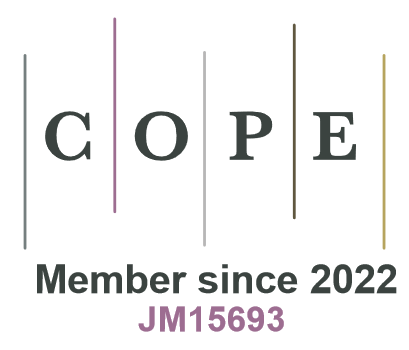Association patterns between 2D:4D ratio and age at menarche: the impact of methodology
DOI:
https://doi.org/10.2478/anre-2020-0026Keywords:
Digit ratio, age at menarche, female reproduction, prenatal hormone exposureAbstract
The ratio of index finger to ring finger length (2D:4D) is a sexually dimorphic feature and widely used as an indicator of prenatal androgen-estrogen exposure. Several studies have investigated the relationship between the 2D:4D ratio and the onset of the first menstrual period (menarche) in women.
The present study tested the association patterns between 2D:4D ratio and age at menarche. Furthermore, the impact of methods of measuring finger lengths was considered.
Two samples were used to conduct the study. One sample consisted of 110 women who self-measured their finger lengths. The finger length measurements in the second sample (88 women) were taken from one trained observer using the caliper-based technique. Age at menarche was determined using a retrospective method.
Women from the first sample reported an average age for the onset of the first menstrual bleeding at 12.9 (SD = 1.4) years of age. There was no significant association between the left and right 2D:4D ratio and the age at menarche. The second sample showed a mean age at menarche at 12.8 (SD = 1.3) years of age. Here, the right hand 2D:4D ratio and age at menarche were significantly correlated (p<0.001).
A more feminine 2D:4D ratio was significantly associated with an earlier menarcheal age only in the sample with direct finger length measurements by a trained investigator. The sample using self-measurements yielded no significant associations between menarcheal age and 2D:4D. The use of a reliable and well-founded methodology is essential for obtaining meaningful results.
Downloads
References
Allaway HC, Bloski TG, Pierson RA, Lujan ME. 2009. Digit ratios (2D:4D) determined by computer-assisted analysis are more reliable than those using physical measurements, photocopies, and printed scans. Am J Hum Biol 21:365–70.
View in Google Scholar
Baker F.1988. Anthropological notes on the human hand. American Anthropologist 1: 57–76.
View in Google Scholar
Berenbaum SA, Bryk KK, Nowak N, Quigley CA, Moffat S. 2009. Fingers as a Marker of Prenatal Androgen Exposure. Endocrinol 150:5119–24.
View in Google Scholar
Caswell N, Manning JT. 2009. A Comparison of Finger 2D:4D by Self-Report Direct Measurement and Experimenter Measurement from Photocopy: Methodological Issues. Arch Sexual Behav 38:143–8.
View in Google Scholar
Gillam L, McDonald R, Ebling FJP, Mayhew TM. 2008. Human 2D (index) and 4D (ring) finger lengths and ratios: Cross-sectional data on linear growth patterns, sexual dimorphism and lateral asymmetry from 4 to 60 years of age. J Anatom 213:325–35.
View in Google Scholar
Gooding DC, Chambers BH. 2018. Age of pubertal onset and 2nd to 4th digit ratios: Preliminary findings. Early Hum Develop 116:28–32.
View in Google Scholar
Helle S. 2010. Does second-to-fourth digit length ratio (2D:4D) predict age at menarche in women? Am J Hum Biol 22:418–20.
View in Google Scholar
Hönekopp J, Bartholdt L, Beier L, Liebert A. 2007. Second to fourth digit length ratio (2D:4D) and adult sex hormone levels: New data and a meta-analytic review. Psychoneuroendocrinology 32:313–21.
View in Google Scholar
Kainz S, Weitzer J, Zingale S, Köllner J, Albrecht C, Gaidora A, Rudorfer MT, Nürnberger A, Kirchengast S. 2017. Are natural scientists more masculine than human-ists? The association between 2D:4D ratio and field of study. Anthrop Anz 75:193–200.
View in Google Scholar
Kalichman L, Batsevich V, Kobyliansky E. 2013. 2D:4D finger length ratio and reproductive indices in Chuvashian population. Am J Human Biol 25:617–21.
View in Google Scholar
Kasielska-Trojan A, Sitek A, Antonszewski B. 2019. Second to fourth digit ratio (2D:4D) in women with carpal tunnel syndrome. Early Hum Dev 137:104829.
View in Google Scholar
Kasielska-Trojan A, Manning JT, Antczak A, Dutkowska A, Kuczynski W, Sitek A, Antonszewski B. 2020. Digit ratio (2D:4D) in women and men with lung cancer. Sci Rep 9:11369.
View in Google Scholar
Kemper CJ, Schwerdtfeger A. 2009. Comparing indirect methods of digit ratio (2D:4D) measurement. Am J Hum Biol 21:188–91.
View in Google Scholar
Kirchengast S, Dottolo E, Praxmarer E, Huber J. 2020. Low digit ratio (2D:4D) is associated with early natural menopause. Am J Hum Biol. 32: e23374. doi:10.1002/ajhb.23374.
View in Google Scholar
Klimek M, Galbarczyk A, Nenko I, Alvarado LC, Jasienska G. 2014. Digit ratio (2D:4D) as an indicator of body size, testosterone concentration and number of children in human males. Ann Hum Biol 41:518–23.
View in Google Scholar
Klimek M, Galbarczyk A, Nenko I, Jasienska G. 2016. Women with more feminine digit ratio (2D:4D) have higher reproductive success. Am J Phys Anthrop 160:549–53.
View in Google Scholar
Koziel S, Kociuba M, Chakraborty R, Sitek A, Ignasiak Z. 2018. Further evidence of an association between low second-to-fourth digit ratio (2D:4D) and selection for the uniformed services: a study among police personnel in Wroclaw Poland. J Biosoc Sci 50:527–39.
View in Google Scholar
Leiner DJ. 2019. SoSci Survey (Version 3.1.06) [Computer software].
View in Google Scholar
Li T, Meng Y, Yao R, Han H, Wu L, Zhou Y, Li Z, Zhang Y, Fu L. 2019. The associations between left-hand digit ratio (2D:4D) and puberty characteristics among Chinese girls. Early Hum Develop 130:22–6.
View in Google Scholar
Lippa RA 2006. Finger lengths 2D:4D ratio and their relation to gender related personality traits and the Big five. Biol Psychol 71:116–21.
View in Google Scholar
Malas MA, Dogan S, Hilal Evcil E, Desdicioglu K. 2006. Fetal development of the hand, digits and digit ratio (2D:4D). Early Hum Develop 82:469–75.
View in Google Scholar
Manning JT, Scutt D, Wilson J, Lewis-Jones DI. 1998. The ratio of 2nd to 4th digit length: A predictor of sperm numbers and concentrations of testosterone, luteinizing hormone and oestrogen. Hum Reprod 13:3000–04.
View in Google Scholar
Manning JT. 2002. Digit ratio: A pointer to fertility, behavior, and health. Rutgers University Press.
View in Google Scholar
Manning JT, Fink B. 2008. Digit ratio (2D:4D), dominance, reproductive success, asymmetry, and sociosexuality in the BBC Internet Study. Am J Hum Biol 20:451–61.
View in Google Scholar
Manning JT, Fink B. 2011. Is low digit ratio linked with late menarche? Evidence from the BBC internet study. Am J Hum Biol 23:527–33.
View in Google Scholar
Manning J, Kilduff L, Cook C, Crewther B, Fink B. Digit Ratio (2D:4D): A Biomarker for Prenatal Sex Steroids and Adult Sex Steroids in Challenge Situations 2014. Front Endocrinol 5:9. doi:10.3389/fendo.2014.00009.
View in Google Scholar
Matchock RL. 2008. Low digit ratio (2D:4D) is associated with delayed menarche. Am J Hum Biol 20:487–89.
View in Google Scholar
Mayhew TM, Gillam L, McDonald R, Ebling FJP. 2007. Human 2D (index) and 4D (ring) digit lengths: Their variation and relationships during the menstrual cycle. J Anatomy 211:630–38.
View in Google Scholar
Muller DC, Baglietto L, Manning JT, McLean C, Hopper JL, English DR, Giles GG, Severi G. 2012. Second to fourth digit ratio (2D: 4D), breast cancer risk factors, and breast cancer risk: a prospective cohort study. Brit J Cancer 107:1631–36.
View in Google Scholar
Oberg AS, Villamor E. 2012. Low digit ratio predicts early age at menarche in Colombian schoolgirls. Paediatr Perinatal Epidemiol 26:448–55.
View in Google Scholar
Pruszkowska-Przybylska P, Sitek A, Rosset I, Sobalska-Kwapis M, Slomka M, Strapagiel D, Zadzinska E. 2018. Association of 2D:4D digit ratio with body composition among the Polish children aged 6–13 years. Early Hum Dev 124:26–32.
View in Google Scholar
Putz DA, Gaulin SJC, Sporter RJ, McBurney DH. 2004. Sex hormones and finger length. What does 2:4D indicate? Evol Hum Behav 25:182–99.
View in Google Scholar
Rasmussen KM 2001. The “Fetal Origins” Hypothesis: Challenges and Opportunities for Maternal and Child Nutrition. Ann Review of Nutr 21:73–95.
View in Google Scholar
Reimers S. 2007. The BBC Internet Study: General Methodology. Arch Sexual Behav 36:147–61.
View in Google Scholar
Schieve LA, Tian L, Dowling N, Croen L, Hoover-Fong J, Alexander A, Shapira SK. 2018. Associations Between the 2nd to 4th Digit Ratio and Autism Spectrum Disorder in Population-Based Samples of Boys and Girls: Findings from the Study to Explore Early Development. J Autism Dev Disord 48:2379–95.
View in Google Scholar
Sitek A, Koziel S, Kasielska-Trojan A, Antoszewski B. 2018. Do skin and hair pigmentation in prepubertal and early pubertal stages correlate with 2D:4D? Am J Hum Biol 30:e12631.
View in Google Scholar
Tabachik M, Sheiner E, Wainstock T. 2020. The association between second to fourth digit ratio, reproductive and general health among women: findings from an Israeli pregnancy cohort. Sci Rep 10, 6341. doi. org/10.1038/s41598-020-62599-3.
View in Google Scholar
Velez MP, Arbuckle TE, Monnier P, Fraser WD. 2016. Female digit length ratio (2D:4D) and time-to-pregnancy. Hum Re-prod 31:2128–34.
View in Google Scholar
World Health Organization 2000. Physical status: the use and interpretation of anthropometry. WHO technical Report Series Geneva.
View in Google Scholar
Zheng Z, Cohn MJ. 2011. Developmental basis of sexually dimorphic digit ratios. PNAS 108: 16289–94.
View in Google Scholar
Downloads
Published
How to Cite
Issue
Section
License

This work is licensed under a Creative Commons Attribution-NonCommercial-NoDerivatives 4.0 International License.








